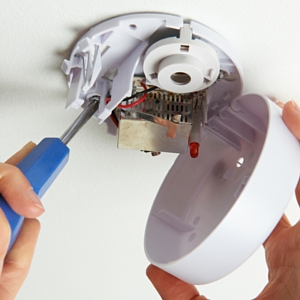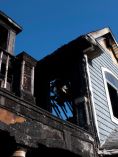
According to the NFPA, nearly three out of five (59%) home fire deaths were caused by fires in properties with no smoke alarms (43%) or smoke alarms that failed to operate (16%).It's difficult to imagine a house not having smoke alarms in this day and age, but according to HouseGrail.com, only 75% of U.S. homes have a working smoke alarm. That leaves a lot of homes unprotected. If your home is unprotected, you need to install a couple, know what kind to install and where to install them.
What Kind to Install
When you go to your local building supply store to buy smoke alarms, you'll see there are different types—ionization, photoelectric or dual sensor. Ionization alarms respond to flames and photoelectric respond to smoldering fires. The best kind to buy is dual sensor, which is a combination of the two.
The next decision you'll need to make is whether to buy a battery operated smoke alarm or one that is hard wired to your home's electrical system and has a battery backup in case the power goes out. The benefit to retrofitting your home with hard wired smoke alarms is that when one goes off, they all go off. This can buy your family precious escape time in the event of a fire. The downside to buying hard wired smoke alarms is they could be costly to install because you'd have to hire an electrician to do the work.
In both battery operated and hard wired options, you have to change the batteries at least twice a year. Replacing the batteries is something many home owners neglect to do. Think of it this way—you can't use your mobile phone if the battery is dead, so you charge it. Wouldn't you want your smoke alarms to work when you need them? They can't if the batteries are dead. If you still can't remember to change them, you might be interested in a new option that's been developed—a smoke alarm with a long-life sealed battery. The batteries in these alarms are sealed so they can't be removed, and they last for 10 years—the average life span of a smoke detector. Although these smoke alarms cost $20-$90 each, it's still cheaper than retrofitting a hard wired smoke detector and more convenient than replacing the batteries twice a year. Don't base your decision on cost or convenience though—your family's lives are more important than either of those things.
Where to Install Them
If your home doesn't have smoke alarms and you are installing them, you should know where to place them:
- One in each bedroom or sleeping room
- One in each hallway outside of bedrooms
- One on each floor of the house
- One in the basement
In addition, since smoke rises, your smoke alarms should be placed high—but not too high. Smoke bounces off walls and ceilings, so ideal placement is 3 feet from the corner of walls and ceilings. Of course, the best thing you can do when determining where to place your smoke alarms is to check with your local fire department.
Already Have Smoke Alarms?
If you already have smoke alarms, make sure you change the batteries twice a year whether you think they need to be changed or not. It's also a good idea to talk with your family about what to do if there's a fire--plan escape routes and a meeting point so you can ensure you are all out of the house and safe.
-
Fire Prevention
 Protect Property
Protect PropertyFire prevention should be top-of-mind all year long, but October is Fire Prevention Month—a good reminder about how to stop fires before they start.
-
Fire for Warmth
 Keep it Cozy
Keep it CozyOn cold winter days, there’s nothing cozier than a fire in the fireplace. That said, you need to keep the chimney clean so there’s not a fire disaster.
-
After a Fire
 Rebuild it Right
Rebuild it RightNobody wants your house to catch on fire, but if it does, you want to make sure you have restoration coverage to rebuild your home in the same style it was before.
